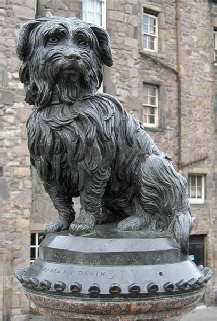



The Parish Church of St George the Martyr, Waterlooville

Festival Edition 2013
A Story of Fidelity
On a recent visit to Edinburgh John and I visited the Kirk of Greyfriars, which was the first church to be built in Edinburgh after the Reformation, taking its name from the Franciscan Friary which was established here in 1447. With permission from Mary Queen of Scots in 1562 the Town Council took over the grounds to use as a cemetery. [This was after the monks had been forced to flee to Europe in 1558]. The burial ground has an impressive collection of tombstones and memorials. The Kirk building was started in 1602 and opened for regular worship at Christmas 1620.
The church receives many visitors due to the fact that John Gray [Auld Jock] was buried here and that his dog Bobby spent most of his days in the burial ground. He became known as Greyfriars Bobby.
The Old Town of Edinburgh, where a weekly market for cattle, sheep and pigs was held, was also surrounded by crowded tenements, packed with large families.
It was in this area John Gray, a police constable lived. At this time Sir Robert Peel’s police force was relatively new and policemen were not very popular, especially with cattle thieves. Four of them regularly guarded the Grassmarket. They were referred to as ‘Peelers’ or ‘Bobbies’. This may explain how John Gray’s little Skye Terrier, came to be called ‘Bobby’. Bobby followed his master everywhere even to his regular eating house at No 6 Greyfriars Place.
John Gray was known as Auld Jock although he was not an old man. Perhaps as a result of his duties out in all weathers, that he died at the age of 45 having contracted tuberculosis. Bobby was only two years old when his master was buried in Greyfriars Kirk yard and he was allowed to attend the funeral. Faithful Bobby could not be expected to know that dogs were not usually permitted in the Kirk yard when he took up his position next to John Gray’s grave and where he stayed day after day. Although shooed away by grave diggers he always returned.
The little dog kept up his vigil for years and John Traill, the owner of the eating house fed him over the next ten years. Bobby learned to take his cue from the one o’clock gun, fired daily from Edinburgh Castle and he would set off for his meal at Traill’s eating house.
In March 1687 the Town Council imposed a licence fee on every dog in the city. Those found to be without a licence were to be put down. Bobby had no official owner -
At the age of 16 Bobby died peacefully in the care of the Traill family and was buried in a flower bed somewhere near the church porch. Before the end of his life a granite fountain with a statue of Bobby was erected outside the church gate. Although the fountain no longer flows the statue still stands, near the site of John Gray’s grave in Greyfriars Kirk yard.
Margaret Symonds
